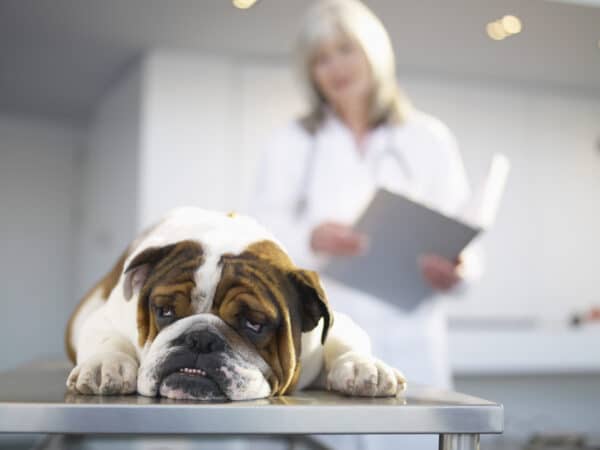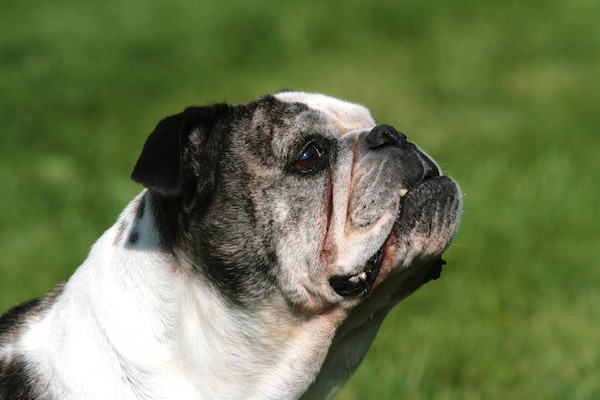Several weeks ago, a gentleman came to my clinic with his English Bulldog. The first thing the man said was, “I think he has a dental abscess.”
Dental abscesses are one of the many unpleasant and unhealthy end results of untreated dental disease. In dogs, a primary feature of dental disease is infection. It is normal for bacteria to inhabit the mouth. Dogs with dental disease suffer from overgrowth of the bacteria, leading to gum recession, bone loss in the face, pain, inflammation, and in some cases dental abscesses.

Dental abscesses occur when infection strikes the tooth root. This may occur as the result of florid periodontal disease, or as a consequence of an injury to the enamel that allows bacteria to gain access to the inside of the tooth. The infection overwhelms the local immune system, and pus fills the site where the root embeds. Swelling and pain result. Any tooth that develops an abscess is severely compromised — in a word, it is rotten. Abscessed teeth require either extraction or root canals.
The symptoms of dental abscesses may be subtle. Dogs with dental abscesses may be lethargic, have poor appetite, have bad breath, be unwilling to consume hard food, and may resent having their mouths handled.
In the case of the Bulldog in question, however, the abscess was not subtle at all. The Bulldog had severe swelling underneath his left eye. In fact, the left eye was swollen shut, and mucoid discharge oozed from it. These symptoms typically occur when the roots of the so-called carnassial tooth (the biggest chewing tooth) become infected. Owners of dogs with this type of dental abscess often wrongly think that the eye is the source of the problem. In fact, the eye is affected secondary to the swelling from the tooth.
The owner of the Bulldog, however, was not mistaken in this fashion. He had correctly diagnosed the problem. I had a hunch it wasn’t his first time at the rodeo, so to speak.
It was not. The owner stated that the dog had suffered a dental abscess in the same area a month before. It had responded well to antibiotics that time.
Here’s the rub: Dental abscesses usually get better with antibiotics. But unless a root canal or tooth extraction occurs, they almost always come back. I discussed this fact, which was self-evident in this particular patient, with the owner.
He said that I was not the first person to tell him what I was telling him. However, he didn’t want to get the abscess properly treated because he thought anesthesia was too dangerous in Bulldogs. To make matters worse, his Bulldog was 9 years old. Wasn’t the procedure too risky?

The easy thing for me to do would have been simply to nod and send the man on his way with some antibiotics and some pain killers. But I owed it to the dog to set the record straight.
The notion of anesthesia being generally dangerous is one of the great myths of medicine. In the last decade and on zero fingers, I can count the number of my patients who died under anesthesia, came close to dying under anesthesia, or had significant anesthetic complications. When one uses modern techniques and agents, anesthesia, for all intents and purposes, is not dangerous at all.
But what about Bulldogs? Isn’t it dangerous to anesthetize them?
With Bulldogs, it’s all about breathing. Bulldogs have great difficulty breathing under the best of circumstances because they have massive amounts of redundant tissue in the backs of their throats. This makes the route through which air flows tortuous.
But during anesthesia, an endotracheal tube (breathing tube) is placed. The tortuous air passages are bypassed, and the airway is secure.
I will confess that there are two stages of anesthesia that are riskier — slightly — in Bulldogs than in other dogs. There is the time after the initial anesthetic has been administered, but before the breathing tube is placed. If an experienced person is inducing anesthesia, the risk is absolutely minimal. It only takes a few seconds to get the tube in.

Also, there is increased risk during the time after the breathing tube is removed but before the dog is fully awake. It has been my experience, however, that most Bulldogs are so happy to — for once in their lives — be able to breathe easily, that they are content to keep the tubes in place until they’re practically up and walking. Again, an experienced clinician should have no trouble managing the risk of this time period.
What about the owner’s last concern, that the dog was too old for anesthesia? On the day I spoke with the owner, that dog was the youngest he ever would be. The dog’s life expectancy was at least a few more years. The dental abscess would keep coming back until it was properly addressed. The safest thing for the dog was to do it sooner rather than later, when the dog would be even older and the bone surrounding the tooth would be even more compromised.
I’m pretty sure I convinced him. At my emergency clinic, we do only the most fundamental emergency dental work, so a root canal was out of the question that day. I provided antibiotics and pain killers and recommended that he follow up for comprehensive dental work with his family vet. I hope he did.
Remember that when it comes to dental disease, an ounce of prevention is worth several pounds of cure. If you brush your dog’s teeth daily, the odds are low that you will ever find yourself in a situation like I just described.
Read more from Dr. Barchas:
- Ask a Vet: Why Are Heartworm Preventatives Starting to Fail?
- Ask a Vet: How Many Legs Does a Dog Need?
- Ask a Vet: Will Medical Marijuana for Dogs Become Commonplace?
Featured Image Credit: Tienuskin, Shutterstock










